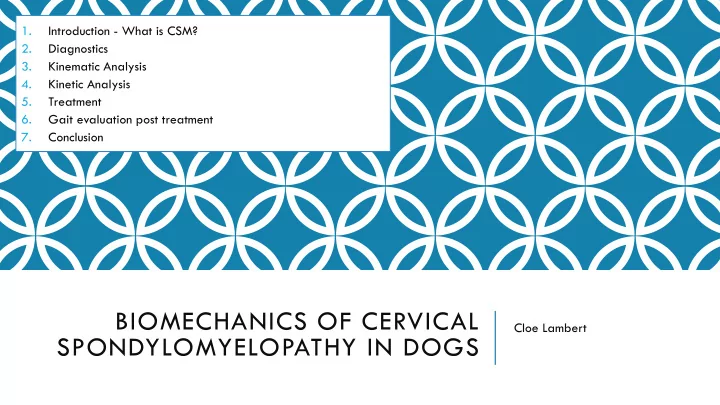

1. Introduction - What is CSM? 2. Diagnostics 3. Kinematic Analysis 4. Kinetic Analysis 5. Treatment 6. Gait evaluation post treatment 7. Conclusion BIOMECHANICS OF CERVICAL Cloe Lambert SPONDYLOMYELOPATHY IN DOGS
WHAT IS CERVICAL SPONDYLOMELOPATHY (CSM) Figure 1: Osseous-associated CSM Figure 2: Disc associated CSM (Da Costa, 2010, Courtesy of The Ohio State University)
DIAGNOSTICS CT Scan MRI Gait Analysis Myelography
KINEMATIC ANALYSIS • Short thoracic limb strides ‘2 - Engine’ Gait • Long pelvic limb strides Research (Foss et al. , 2013b; Lima et al., 2015): • Smaller minimum and maximum thoracic limb distance in CSM dogs than ‘normal’ dogs. • Stride length of forelimbs is significantly shorter in CSM dogs. • Smaller flexion and extension of all limbs in CSM dogs. • Reduced stifle flexion and extension. Thoracic limb distance • Fewer pelvic limb strides in a given distance. Figure 3: Dog front stance (Schlehr, 2018) • Exaggerated Truncal sway. • Tetraparesis or tetraplegia. • Ataxia.
KINETIC ANALYSIS Figure 4: Boxplot of the coefficient of variation in the PVF in normal and CSM-affected dogs Research by (Foss et al. , 2013a; Lima et al. , 2015): • No major difference between normal dogs and dogs with CSM. • Only significant difference appears to be variability of peak vertical force of the forelimbs. (Foss et al. , 2013a)
(Fitzpatric Referals, 2015)
(Southeast Veterinary Neurology of Miami, 2012)
TREATMENT • NSAIDS OR Corticosteroids = 30-50% success (Decker et al., 2012) 80% success (Decker et al., 2012) • Surgical treatment = • Electroacupuncture and sometimes surgery = 85% success (Sumano et al., 2000) Limited success; case study: 2/3 dogs improved (Speciale and Fingeroth, 2000) • Physiotherapy = Pain relief provided but still referred for surgery (Padilha et al., 2018)
GAIT EVALUATION POST-TREATMENT ✓ Peak vertical force (PVF) of the forelimbs was significantly more consistent. ✓ Truncal sway was improved. ✓ Stifle ROM increase. Foss et al., (2018)
(Marie, 2017)
CONCLUSION • Kinematics: Two engine gait is a key sign. • Kinetics: PVF of forelimbs in CSM dogs varies. • Kinematic analysis proves more useful in diagnosis of CSM than kinetic analysis. • Both kinematic and kinetic analysis may be useful in showing progression of the condition after the dog receives treatment.
REFERENCES Da Costa, R. (2010) Cervical Spondylomyelopathy (Wobbler Syndrome). Journal of the American Veterinary Medical Association. 40 , 881 – 913. Da Costa, R., Parent, J., Holmberg, D., Sinclair, D., Monteith, G. (2008) Outcome of medical and surgical treatment in dogs with cervical Spondylomyelopathy: 104 cases (1988 – 2004). Veterinary Clinics Small Animal. 233 (8), 1284 – 1290. Decker, S., Bhatti, S., Duchateau, L., Martle, V., Van Soens, I., VanMeervenne, S., Saunders, J., Van Ham, L. (2009) Clinical evaluation of 51 dogs treated conservatively for disc-associated wobbler syndrome. Journal of Small Animal Practice. 50 , 136 – 142. Decker, S., Da Costa, R., Volk, H., Van Ham, L. (2012) Current insights and controversies in the pathogenesis and diagnosis of disc-associated cervical Spondylomyelopathy in dogs. Veterinary Record. 171 , 531 – 537. Delamaide Gasper, J., Rylander, H., Stenglein, J., WallerIII, K. (2014) Osseous-associated cervical Spondylomyelopathy in dogs: 27 cases (2000 – 2012). Journal of the American Veterinary Medical Association . 244 (11), 1309 – 1318. Fitzpatric Referals (2015) Typical gait pattern that may be observed in a dog with cervical disc disease. Available from: https://www.youtube.com/watch?v=6_6cNZOYbL4 [Accessed November 18, 2018]. Foss, K., Da Costa, R., Rajala-Shultz, P., Allen, M. (2013a) Force Plate Gait Analysis in Doberman Pinschers with and without Cervical Spondylomyelopathy. Journal of Veterinary Internal Medicine. 27 , 106 – 111. Foss, K., Da Costa, R., Moore, S. (2013b) Three-Dimensional Kinematic Gait Analysis of Doberman Pinschers with and without Cervical Spondylomyelopathy. Journal of Veterinary Internal Medicine . 27 , 112 – 119.
REFERENCES Foss, K., Smith, R., Da Costa, R. (2018) Kinetic and kinematic follow-up gait analysis in Doberman Pinschers with cervical Spondylomyelopathy treated medically and surgically. Journal of Veterinary Internal Medicine. 32 , 1126 – 1132. Lima, C., Da Costa, R., Foss, K., Allen, M. (2015) Temporospatial and kinetic gait variables of Doberman Pinschers with and without cervical Spondylomyelopathy. American Journal of Veterinary Research . 76 (10), 848 – 852. Marie, L. (2017) Dog with Wobbler Syndrome. Available from: https://www.youtube.com/watch?v=qTnJSrdcm8U&t=117s [Accessed November 18, 2018]. Padilha, G., Pereira, L., Ferreira, M., Fonseca, F., Carvalho, A., Pontes, M., D’Alcabtara , N., Lima, J., Nascimento, J., Souza, W. (2018) Physiotherapeutic approach in a dog with Wobbler’s Syndrome: case report. Pubvet. 12 (7), 1 – 6. Schlehr, M. (2018) Dog conformation shot (front) . [online]. Available from: https://breedingbetterdogs.com/article/structure- and-movement-pt-1 [Accessed November 18, 2018]. Shekhar, P., Singh, G., Kumar, S., Kumer Singh, A., Choudhury, S., Shukla, A. (2018) Wobblers syndrome in Labrador and rottweiler pups: an emerging concern in canines: A review. International journal of science, environment and Technology . 7 (1), 361 – 364. Southeast Veterinary Neurology of Miami (2012) German Shepherd with Wobbler Syndrome | Two Engine Gait. Available from: https://www.youtube.com/watch?v=43LOWZTSv-o [Accessed November 18, 2018]. Speciale, J., Fingeroth, J. (2000) Use of physiatry as the sole treatment for three paretic or paralyzed dogs with chronic compressive conditions of the caudal portion of the cervical spinal cord. Journal of American Veterinary Medicine Association. 217 (1), 43 – 47. Sumano, H., Bermudez, E., Oregon, K. (2000) Treatment of wobbler syndrome in dogs with electroacupuncture. Dtsch Tierarztl Wochenschr . 107 (6), 231 – 235.
Recommend
More recommend